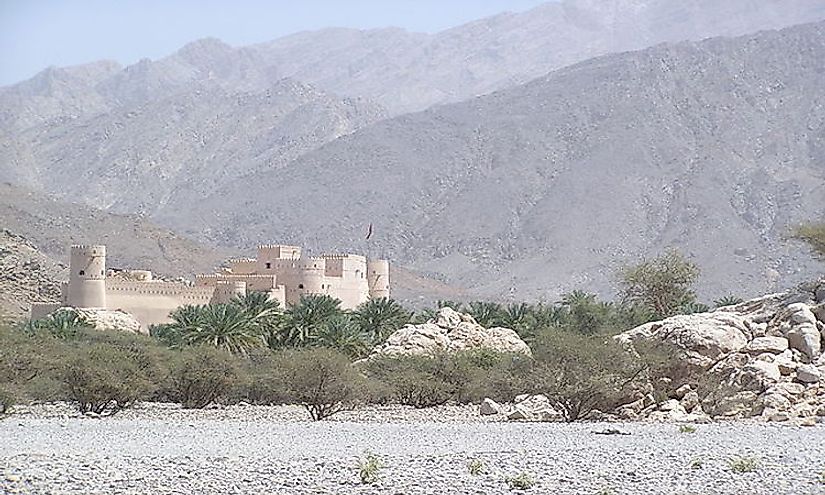Ecological Regions Of Oman

Oman’s geography and ecosystems are characterized by an arid inland and coastal shorelines and waters. Located on the Arabian Peninsula, Oman has stretches of coastlines along the Arabian Sea, the Persian Gulf, and the Gulf of Oman. The country borders other Arabian countries such as Yemen, Saudi Arabia, and the United Arab Emirates.
Ecological Regions Of Oman
Al Hajar Al Gharbi Montane Woodlands
The Al Hajar Al Gharbi montane woodlands ecoregion is classified in the Temperate Grasslands, Savannas, and Shrublands Biome. The ecoregion is situated within the Al Hajar Mountain Range, the highest mountain range in eastern Arabia. Cretaceous limestone and ophiolites comprise most of the mountains’ terrain.
The ecoregion’s climate is cool and wet between the months of December and March. Temperature increases between April and September with occasional rain and thunderstorms. Vegetation in the region varies with altitude. Fig and Wadi species in the lower elevations form the shrubland. Fig and olive trees are most common in the mid elevations and junipers, and Olea europea form impressive woodland at higher elevations.
The region supports various fauna such as the Arabian Tahr alongside the Arabian gazelle, wild cat, leopard and striped hyena. Avifauna in the region is represented by species such as Yemen Linnet, Arabian partridge, Graceful Warbler, lappet-faced vulture and Black kite.
The major threats to this ecoregion are over-grazing by cattle, poaching, and human encroachment. Protected areas in the region include the Wadi Sareen Reserve and the Jebel Qahwan-Jebel Sebtah.
Gulf Of Oman desert And Semi-Desert
The Gulf of Oman desert and semi-desert is classified in the Deserts and Xeric Shrublands Biome. The ecoregion is located in the Arabian Peninsula along the coastlines of the Gulf of Oman and the Persian Gulf in Oman and the United Arab Emirates. The region is home to several habitats including lagoons, savanna, mangrove swamps, and acacia trees. The region’s climate is hot and dry, and it receives little rain while temperatures can be as high as 49 degrees Celsius.
Prosporis cineraria dominate the savanna regions while Avicennia marina characterizes the mangrove areas. Masirah Island in the ecoregion is an important breeding site for the largest populations in the world of loggerhead sea turtles alongside other turtles such as green and hawksbill turtles. The Arabian Tahr and Arabian leopard which roam in the regions are notable victims of poaching.
Over-grazing, urban development and oil pollution in the sea are some of the environmental threats in the region. The major conservation area in this ecoregion is the Khor Kalba Nature Reserve.
The Arabian Desert And East Sahero-Arabian Xeric Shrublands
This ecoregion is classified in the Deserts and Xeric Shrublands Biome. The ecoregion is the largest in the Arabian Peninsula. It is a desert ecoregion native to Oman, Yemen, UAE, Jordan, Iraq, and Syria. The ecoregion is renowned as the largest continuous body of sand in the world. Located in the ecoregion is the Tuwayq escarpment which is home to a variety of landforms such as canyons, plateaus, and limestone cliffs.
The region receives little rainfall per year, less than 35 mm. The region supports little vegetation with the most common floral species being Calligonum crinitum, Limeum arabicum, and Cyperus conglomeratus. The highly adapted fauna of the region includes the striped hyena, oryx, gazelles, Nubian ibex, Arabian tahr, red fox, and Arabian wolf.
Off road driving, overgrazing, and poaching are some of the identified threats to the region. The ecoregion is inadequately protected from these threats.
Arabian Peninsula coastal fog desert
This ecoregion is classified under the Deserts and Xeric Shrublands Biome. The region stretches along the coastlines of Oman, Yemen, and Saudi Arabia. The region is characterized by thick fogs which reduce visibility to only 33 feet. The fog supplies the region with the moisture needed to support its high plant and animal diversity. The region is home to nearly 900 vascular plants, and 60 of them are endemic to the region. The most renowned flora species is the frankincense tree for its economic and medicinal value.
Abundant fauna inhabits the region such as large populations of the Arabian gazelle and the Arabian leopard. Striped hyena, wild cat, red fox, Nubian ibex, Arabian wolf and Arabian sand gazelle roam the region. Urban development, deforestation, and overgrazing are environmental challenges identified in the region. The government of Oman has attempted to mitigate these challenges through the Jebel Samhan of Dhofar Nature Reserve and the Arabian Oryx Sanctuary.
Other Ecoregions Of Oman
Other ecoregions of Oman include the Gulf of Oman, the Red Sea Nubo-Sindian tropical desert and semi-desert, Southwestern Arabian foothills savanna and the Western Arabian Sea. Urban development is a chief characteristic of a rapidly developing nation like Oman, and continues to take its toll on the ecoregions of the country. The government is doubling up efforts towards more sustainable development.
Ecological Regions Of Oman
| Ecological Regions of Oman | Biome |
| Al Hajar Al Gharbi montane woodlands | Temperate Grasslands, Savannas, and Shrublands |
| Arabian Desert and East Sahero-Arabian xeric shrublands | Deserts and Xeric Shrublands |
| Arabian Peninsula coastal fog desert | Deserts and Xeric Shrublands |
| Gulf of Oman | Marine |
| Gulf of Oman desert and semi-desert | Deserts and Xeric Shrublands |
| Red Sea Nubo-Sindian tropical desert and semi-desert | Deserts and Xeric Shrublands |
| Southwestern Arabian foothills savanna | Deserts and Xeric Shrublands |
| Western Arabian Sea | Marine |







